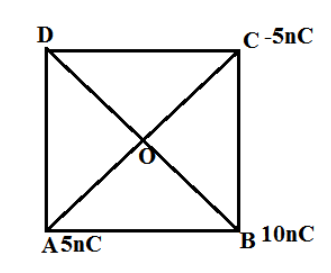
Answer
430.2k+ views
Hint: Here side of the square is given. By using side, firstly we will find the diagonal value. Then we will find the value of potential at point O and D due to all other three charges that are given in this particular question. Then we use the work done formula which is the product of charge and the potential difference (\[W = v.q\] ).
Complete step by step answer:
Given that, Side of Square ABCD\[ = 2m\]

Three charges are given which are placed at the corner of the square (as shown).
Now we can see,
AC=BD=\[\sqrt {{{(2)}^2} + {{(2)}^2}} \] \[ = \sqrt {4 + 4} \]
=\[2\sqrt 2 \] \[ = 2.28m\]
Now, AO=BO=CO=\[\dfrac{{2.828}}{2} = 1.414m\]
Potential at O, \[{V_o} = \]\[\dfrac{1}{{4\pi {\varepsilon _0}}}\left[ {\dfrac{{{q_1}}}{{AO}} + \dfrac{{{q_2}}}{{BO}} + \dfrac{{{q_3}}}{{CO}}} \right]\]
Potential at D, \[{V_D} = \dfrac{1}{{4\pi {\varepsilon _0}}}\left[ {\dfrac{{{q_1}}}{{AD}} + \dfrac{{{q_2}}}{{BD}} + \dfrac{{{q_3}}}{{CD}}} \right]\]
Now, we know
Work done\[ = q\left[ {{v_O} - {v_D}} \right]\]
Charge \[q\] is given and we can find potential at point O and D .
So, W\[ = 5 \times {10^{ - 6}} \times 9 \times {10^9} \times \left[ {5 \times {{10}^{ - 9}}\left[ {\dfrac{1}{{AO}} - \dfrac{1}{{AD}}} \right] + 10 \times {{10}^{ - 9}}\left[ {\dfrac{1}{{BO}} - \dfrac{1}{{BD}}} \right]} \right]\]
\[\Rightarrow W = 45 \times {10^{ - 6}} \times {10^9} \times {10^{ - 9}}\left[ {5 \times \left( {\dfrac{1}{{1.414}} - \dfrac{1}{2}} \right) + 10 \times \left( {\dfrac{1}{{1.414}} - \dfrac{1}{{2.828}}} \right)} \right]\]
\[ \Rightarrow W = 450 \times {10^{ - 6}} \times \left( {\dfrac{1}{{1.414}} - \dfrac{1}{{2.828}}} \right)\]
\[\Rightarrow W = \dfrac{{450 \times {{10}^{ - 6}}}}{{1.414}}\left( {1 - \dfrac{1}{2}} \right) = 159.12 \times {10^{ - 6}}Joules\]
So, \[159.12 \times {10^{ - 6}}joules\] work is done transferring a charge of \[5\mu C\] from D to the point of intersection of diagonals.
Note: Potential difference between two points is the total amount of work is done to transfer a unit charge from one point to another. \[v = \dfrac{w}{q}\]
Here,\[v\] is the potential ,\[w\] is the work done and q is the charge. After knowing the value of potential and charge, we can easily find how much work is done. Work done is calculated in \[joules\] . When \[1 coulomb\] of charge is transferred and potential difference is \[1volt\] then the work done is said to be \[1joule.\]
Complete step by step answer:
Given that, Side of Square ABCD\[ = 2m\]

Three charges are given which are placed at the corner of the square (as shown).
Now we can see,
AC=BD=\[\sqrt {{{(2)}^2} + {{(2)}^2}} \] \[ = \sqrt {4 + 4} \]
=\[2\sqrt 2 \] \[ = 2.28m\]
Now, AO=BO=CO=\[\dfrac{{2.828}}{2} = 1.414m\]
Potential at O, \[{V_o} = \]\[\dfrac{1}{{4\pi {\varepsilon _0}}}\left[ {\dfrac{{{q_1}}}{{AO}} + \dfrac{{{q_2}}}{{BO}} + \dfrac{{{q_3}}}{{CO}}} \right]\]
Potential at D, \[{V_D} = \dfrac{1}{{4\pi {\varepsilon _0}}}\left[ {\dfrac{{{q_1}}}{{AD}} + \dfrac{{{q_2}}}{{BD}} + \dfrac{{{q_3}}}{{CD}}} \right]\]
Now, we know
Work done\[ = q\left[ {{v_O} - {v_D}} \right]\]
Charge \[q\] is given and we can find potential at point O and D .
So, W\[ = 5 \times {10^{ - 6}} \times 9 \times {10^9} \times \left[ {5 \times {{10}^{ - 9}}\left[ {\dfrac{1}{{AO}} - \dfrac{1}{{AD}}} \right] + 10 \times {{10}^{ - 9}}\left[ {\dfrac{1}{{BO}} - \dfrac{1}{{BD}}} \right]} \right]\]
\[\Rightarrow W = 45 \times {10^{ - 6}} \times {10^9} \times {10^{ - 9}}\left[ {5 \times \left( {\dfrac{1}{{1.414}} - \dfrac{1}{2}} \right) + 10 \times \left( {\dfrac{1}{{1.414}} - \dfrac{1}{{2.828}}} \right)} \right]\]
\[ \Rightarrow W = 450 \times {10^{ - 6}} \times \left( {\dfrac{1}{{1.414}} - \dfrac{1}{{2.828}}} \right)\]
\[\Rightarrow W = \dfrac{{450 \times {{10}^{ - 6}}}}{{1.414}}\left( {1 - \dfrac{1}{2}} \right) = 159.12 \times {10^{ - 6}}Joules\]
So, \[159.12 \times {10^{ - 6}}joules\] work is done transferring a charge of \[5\mu C\] from D to the point of intersection of diagonals.
Note: Potential difference between two points is the total amount of work is done to transfer a unit charge from one point to another. \[v = \dfrac{w}{q}\]
Here,\[v\] is the potential ,\[w\] is the work done and q is the charge. After knowing the value of potential and charge, we can easily find how much work is done. Work done is calculated in \[joules\] . When \[1 coulomb\] of charge is transferred and potential difference is \[1volt\] then the work done is said to be \[1joule.\]
Recently Updated Pages
How many sigma and pi bonds are present in HCequiv class 11 chemistry CBSE

Mark and label the given geoinformation on the outline class 11 social science CBSE

When people say No pun intended what does that mea class 8 english CBSE

Name the states which share their boundary with Indias class 9 social science CBSE

Give an account of the Northern Plains of India class 9 social science CBSE

Change the following sentences into negative and interrogative class 10 english CBSE

Trending doubts
Difference Between Plant Cell and Animal Cell

Fill the blanks with the suitable prepositions 1 The class 9 english CBSE

Difference between Prokaryotic cell and Eukaryotic class 11 biology CBSE

Differentiate between homogeneous and heterogeneous class 12 chemistry CBSE

Write a letter to the principal requesting him to grant class 10 english CBSE

Give 10 examples for herbs , shrubs , climbers , creepers

Write the differences between monocot plants and dicot class 11 biology CBSE

Change the following sentences into negative and interrogative class 10 english CBSE

Why is there a time difference of about 5 hours between class 10 social science CBSE



